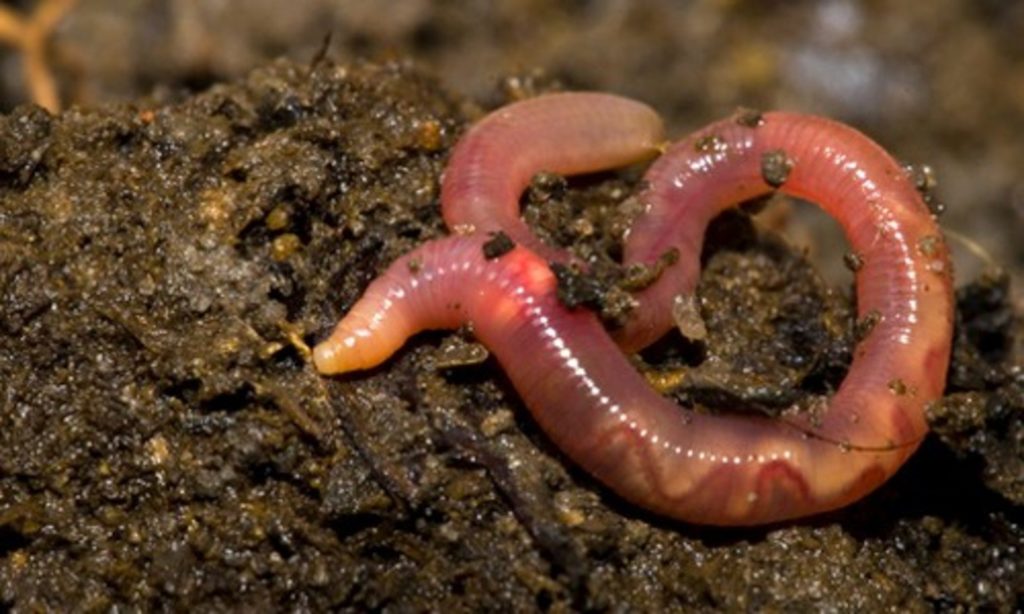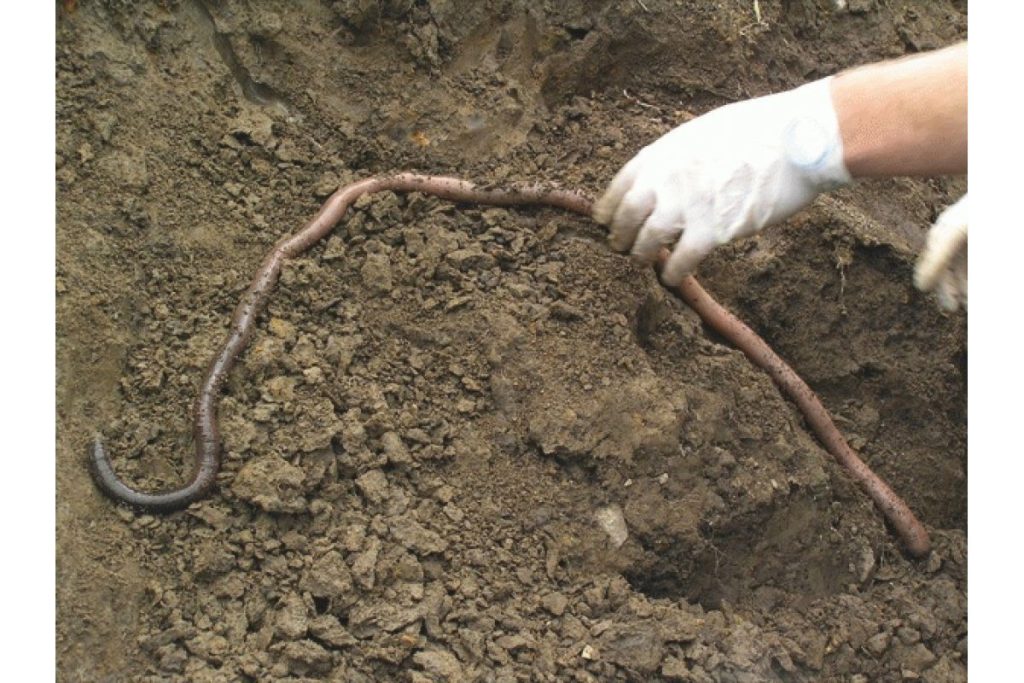On a dear, crisp afternoon the sun casts dappled shadows on the leafy wildlife garden outside London’s Natural History Museum where Emma Sherlock is heading for the compost heap. She lifts the lid and peers underneath, then beams. “There they are,” she says. Sure enough, glistening against a background of dark, decaying plant matter are the writhing bodies of not one, but several, earthworms. She teases one from its warm, peaty bed and lays it neatly across the palm of her hand. A couple of inches long, the earthworm’s stripy, segmented body has the hue of a well-aged Merlot. When she nudges it gently, it squirms then, unexpectedly, oozes a small blob of bright yellow goo from its tail end. “Do you see that? Have a sniff,” she says, proffering me her palm. I inhale in the wormy aroma. It’s acrid and unpleasant, and we wrinkle our noses. “They do that to deter predators,” says Emma. “Aren’t they incredible?”
AMAZING TALENTS
Earthworms, it seems, are full of surprises. Far from the boring, brown wrigglers of common misperception, they are a diverse and dazzling bunch, hill of unexpected quirks and peculiarities. Some Asian earthworms, for example, avoid being eaten by launching themselves into the air, while other species deliberately detach their tail, which then wiggles enticingly whilst the front half sneaks off and quietly regrows the missing appendage. They come in all sorts of colours – red, blue and green – and all sorts of patterns. Some are striped, and there is even one species from the Philippines that looks as if it has been pelted with miniature fried eggs. Some glisten with an iridescent sheen, others luminesce. The unsung heroes of the underground, earthworms provide round the clock ecosystem services that mankind would struggle to live without. We literally walk all over them, yet few of us have ever paused to consider their beauty or their value, and the truth is, there is just so much about them that we still don’t know. Emma Sherlock, champion of the humble earthworm, hopes to change all that.

We carefully place the annoyed invertebrate back in its rotting residence and replace the cover. “Most people think there’s just one type of earthworm,” says Sherlock, “but there’s at least 27 different species in the UK, and 5,000 or more in the world.” Eisenia fetida, the compost worm, is just one of them. The big reddish-brown one – Lumbricus terrestris – which is loved by gardeners and robins alike, is another. It can grow up to 40cm long, she explains. Lumbricus terrestris spends most of its life hidden in deep earthy burrows, but when the sun goes down it pokes its head above ground to grab leaves and other fallen plant matter. It anchors itself into the ground with its flattened spadelike tail then silently drags its bounty down into the deep where it is consumed. “If s an amazing sight,” says the curator. “They’re so muscular and powerful, and yet so gentle all at the same time.” Sherlock, who has a lifelong love of natural history, became bitten by the earthworm bug when she was invited to study them in Romania with earthworm doyenne Victor Pop.
A senior scientist at the Institute of Biological Research, Cluj-Napoca, Pop makes for an enigmatic mentor. He wears bottle-top glasses and a smile that is as broad as it is infectious. His workroom is full of pickled worms in tall test-tubes, and like his father before him Pop has dedicated his life to cataloguing the earthworms of his homeland. Sherlock spent weeks in Pop’s company, studying his collection, learning field skills and hunting for giant earthworms on the leaf-littered slopes of the Carpathian Mountains. It’s there that she first met Octodrilus permagnus, a species of earthworm first discovered by Pop over 25 years ago, that grows to over 1.5m long. “They’re really impressive,” she says. It’s the biggest earthworm in Europe, but not the world. That title goes to the whopping giant Gippsland earthworm of Australia, which can sometimes exceed 2m in length.
CABINET OF CURIOSITIES
Inspired by the diversity she witnessed and by Pop’s generous spirit, Sherlock now manages the Natural History Museum’s extensive earthworm collection in her guise as senior curator of free-living worms and Porijera. The museum has thousands of specimens from all I over the world. Most are hidden away inside tall locked cupboards, while in her laboratory every conceivable inch 3 of worktop space is covered… in worms. Bleached by the preservatives that protect their bodies, they lie curled up I inside jam jar after jam jar. “She picks one up and carefully teases out its contents. The fruit of a Carpathian foray, the ghostly earthworm dangles from her fingers like a strand of fat, rubbery spaghetti. This one is about 30cm long, so it’s a relative youngster. She shows me its muscular hooked mouthpart.

We can tell if an adult, she explains, because of its thick belt, the clitellum. Famously hermaphrodite, amorous worms pair up head-to-tail before exchanging sperm. The suitor’s seed is then stored in special sacs called spermatecea, but when the time is right it is released along with the worm’s own eggs into a wad of mucous produced by the clitellum. Fertilisation occurs and the sticky structure is then shed into the soil where it dries to become the egg capsule from which new life will hatch. It’s Sherlock’s goal to collect, catalogue and study as many of the world’s earthworms as she can, but she’s far from the first to be captivated by the unassuming annelids’ charms. People have been fascinated by earthworms for thousands of years. When he wasn’t pontificating on the nature of existence, Greek philosopher Aristotle described them as the “intestines of the earth”. Charles Darwin, who studied them in detail, dubbed them “nature’s ploughs” on account of their ability to mix soil and organic matter.
EXCITING DISCOVERY
In 2015, there was a flurry of excitement when Sherlock discovered an earthworm that had been presumed extinct in the UK, hiding inside a rotting log in the Natural History Museum’s very own wildlife garden. One of the UK’s smallest earthworms, Dendrobaena pygmaea hadn’t been seen for 32 years. “It was such a surprise to find it,” says the annelid enthusiast, “and on our own doorstep, too.” Since then the same species has been found in four different locations, but while the discoveries are undoubtedly good news for earthworm biodiversity, they highlight a profound predicament. “The problem,” she says “is that we don’t really know what earthworms we have.” Recently, she tried to pool all the scientific data she could muster and plot the distribution of the various UK earthworm species on a map of the country, only to find that the dots were disappointingly sparse. But it wasn’t necessarily that the earthworms were scarce, rather, simply, that the data didn’t exist. “We know very little about their distribution and exact habitat preferences because there are just not enough people recording earthworms.”
GETTING YOUR HANDS DIRTY
This pervasive problem extends far beyond the UK. Vast swathes of the world are completely unsurveyed. Nicaragua, for example, has no species list for earthworms. So when Sherlock went there on a field trip in 2009 and found a bluey-purple worm hiding inside a bromeliad plant, it was inevitably a new species. She named it Eutrigaster (Grajfia) azul because ‘azul’ is the Spanish word for blue. Concerned by the dearth of earthworm data and the lack of willing recorders, Sherlock is making a stand for the earthworm. She is a proud co-founder of the Earthworm Society of Britain, a friendly organisation set up in 2009 that promotes wormy citizen science and entices anyone who doesn’t mind getting their hands dirty to dig in the garden and then report what they find. They offer training courses, identification skills and a chance for anyone to add dots to Sherlock’s UK earthworm map.

The first step is to build up a picture of the earthworms that we have today, then to monitor populations and species to see how they change over time. Only then will scientists be able to know how healthy or otherwise our earthworm populations are. By spreading love and respect for the earthworms of our native soils, the Earthworm Society of Britain aims to help conserve earthworms and their habitats, and to educate and inspire people so these fantastic creatures can be enjoyed for many, many years to come. “There is so little data out there,” Sherlock says, “that any earthworm enthusiast who wants to start recording has the potential to make a real difference.” So perhaps we should be getting a wriggle on. I think I it’s time we gave the earthworm; Earth’s most unloved altruist, the recognition it so richly deserves.














